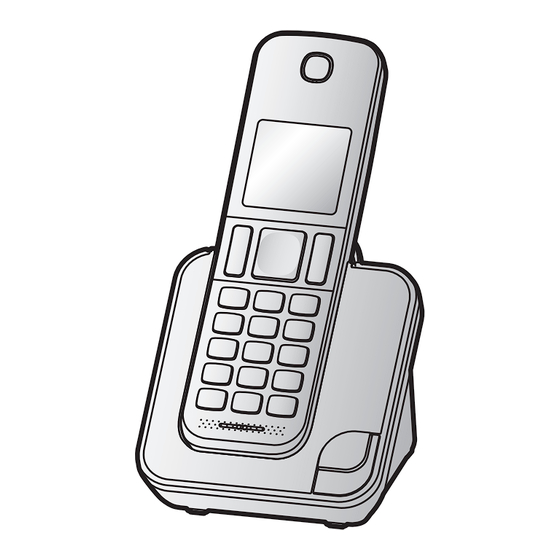Table of Contents
Advertisement
Quick Links
Model shown is KX-TGD310.
Before initial use, see "Getting Started"
on page 10.
Thank you for purchasing a Panasonic product.
Please read these operating instructions before using the unit and save them for
future reference.
Operating Instructions
Model No.
Digital Cordless Answering System
Model No.
Digital Cordless Phone
KX-TGD310BX
KX-TGD312BX
KX-TGD310UE
KX-TGD312UE
KX-TGD320BX
KX-TGD322BX
KX-TGD320UE
KX-TGD322UE
Advertisement
Table of Contents

Summarization of Contents
Operating Instructions
Product Overview
Introduces the Panasonic phone models and provides basic usage information.
Introduction
Model Composition and Accessories
Details the phone models, their components, and supplied accessories for setup.
Graphical Symbols
Explains common symbols used throughout the equipment and manual.
Important Information
Safety and Operating Precautions
Covers essential safety, installation, and operating guidelines for product use.
Best Performance Tips
Provides tips for optimal product performance and essential safety instructions.
Environment, Care, and Disposal
Guidelines for product placement, maintenance, disposal, and handling notices.
Getting Started
Initial Setup and Connections
Guides through connecting the base unit, charger, and telephone line for initial setup.
Battery Installation and Charging
Provides instructions for battery handling, installation, and charging procedures.
Handset and Base Unit Controls
Identifies and explains the buttons and functions on the handset and base unit.
Basic Settings: Power, Language, Date/Time
How to turn the device on/off, set language, and configure date and time.
Making/Answering Calls
Basic Call Operations
Covers making calls, answering calls, using the speakerphone, and adjusting volume.
Advanced Call Features
Details on hold, mute, call waiting, call transfer, and equalizer functions.
Intercom and Power Backup
Instructions for intercom calls, key lock, and phone operation during power outages.
Phonebook
Managing Phonebook Entries
Adding, storing, categorizing, and editing contacts in the phonebook.
Speed Dial and Entry Management
Setting up, editing, and erasing speed dial numbers and phonebook entries.
Programming
Menu Navigation and Command Codes
Explains how to access features via menus and direct command codes.
Answering System and Time Settings
Configuration options for the answering system and date/time related settings.
Ringer and Do Not Disturb Settings
Customizing ringers, volume, and setting Do Not Disturb mode.
Alarm Settings
How to set and configure alarms with memo and snooze functions.
Unit Registration and Repeater Setup
Registering units, canceling registrations, and extending range with repeaters.
Caller ID Service
Using Caller ID and Managing Call Lists
Explains Caller ID features, viewing the caller list, and editing entries.
Erasing Caller Information
How to delete selected or all call log entries from the device.
Answering System
System Setup and Greeting Messages
Turning the system on/off and managing greeting messages.
Message Playback and Management
Playing, rewinding, fast-forwarding, and erasing recorded messages.
Remote Operation and Commands
How to operate the answering system remotely using voice and commands.
Answering System Settings and Voicemail Integration
Call screening, ring counts, voicemail integration, and recording time settings.
Useful Information
Voicemail Service and Character Entry
Information on voicemail services and how to enter characters using the keypad.
Error Messages and General Troubleshooting
Lists common error messages and provides general troubleshooting steps.
Troubleshooting Common Issues
Covers issues with unit operation, display, dial tone, and battery performance.
Answering System and Liquid Damage Troubleshooting
Troubleshooting answering system problems and issues related to liquid damage.















Need help?
Do you have a question about the KX-TGF310 and is the answer not in the manual?
Questions and answers